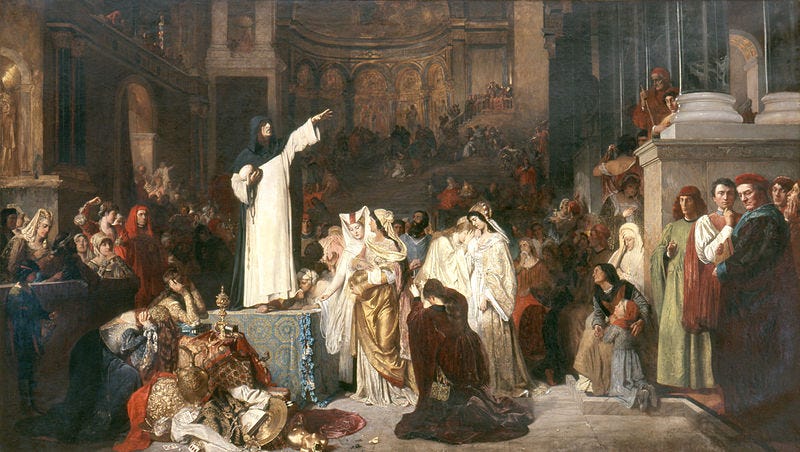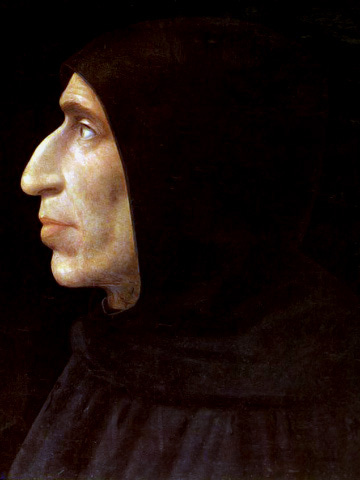No, not the Tom Wolfe novel from the 1980s – he’s old, but not that old. Though, like the book, this is a story of social class, politics, and greed, or at least the perception of those things. This was a literal bonfire that occurred on 7 February 1497, where the Dominican priest Girolamo Savonarola directed a bunch of loyal followers to burn objects he (and by implication the Catholic Church) thought were “vain,” hence “vanities.”

Savonarola came from a wealthy family in Ferrara, in north eastern Italy, where he was born in 1452. In his early twenties he joined the Dominican Order, a sect that valued academic study and education along with its adherence to Catholic prayer. As a preacher and friar Savonarola sermonized about repentance and reform within the Church, cities, and people. He especially despised and denounced clerical corruption, despotic rule, and the exploitation of the poor, i.e. he had issues with the exploitation of the lower social classes by the greedy. Savonarola also claimed to be a prophet, suggesting that the destruction of the Church was close at hand. Many people thought the prophecy came true when, in 1494, the French king crossed the Italian Alps with a large army that threw the Italian political scene into chaos. He parlayed that chaos and intercession with the king to become de facto ruler in Florence later in 1494, a city where he’d been working since 1490.
Seen as a prophet, he soon gained many followers and wielded great political influence in Florence. He urged the passing of laws against "sodomy" (which he meant as any sort of homosexual relations), adultery, public drunkenness, and other moral transgressions. He also organized his youngest followers to patrol the streets to curb what they deemed as immodest dress or behavior. Seems like a fun guy.
Savonarola led a fairly ascetic lifestyle devoid of much material comfort, unlike the luxurious trappings of the leaders of the church. This lifestyle, along with his strict moralistic preaching – often against the corrupt and hedonistic state of the Church – brought Savonarola into conflict with the Pope, the head of the Catholic church (and returned back to Rome). Fearful of losing power to the invading French king, Pope Alexander VI formed the Holy League with numerous Italian city-states including Sicily, Milan, and Venice (and eventually England as well) to battle against French influence. Pope Alexander wanted Florence to join the League, but Savonarola, as the ruler of the city, declined to become a member. The Pope summoned Savonarola to Rome to discuss the matter, but Savonarola refused to go. In response, the Pope banned Savonarola from preaching; an order which Savonarola ignored.
A regular festival in the Christian calendar is Carnival (famously taking place in Rio in the modern era; or elsewhere in New Orleans for Mardi Gras). Typically a time of celebration and excess before the more somber period of Lent, Savonarola began protesting the lavish spectacles and inducements to sin. During Shrove Tuesday (aka Mardi Gras), on 7 February 1497 Savonarola led his followers in a protest by burning things he thought might lead to temptation and sin – his bonfire of the vanities. These included cosmetics, mirrors, poetry, art, books, fine clothing, playing cards, and musical instruments (or, you know, things that might help people have fun and feel happy).

This massive bonfire railing against Church excess, along with his continued preaching and refusal to join the Holy League, led Pope Alexander to excommunicate Savonarola in May 1497. He was charged with heresy and sedition (Savonarola supposedly called the Church a whore, which obviously did not go over well with the Pope), and executed on 23 May 1498, in the same square, the Piazza della Signoria, where he had previously held his bonfires of the vanities. Ironically, Savonarola’s body was burnt (a bonfire of the vain?) after he was hanged.
Despite his death, perhaps because of his perceived martyrdom, Savonarola’s reformist tendencies grew. Though the Pope banned Savonarola’s writings, they spread to Switzerland and Germany, including into the hands of Martin Luther, which helped inspire the Protestant Reformation. In fact, the officials of Wittenberg, the hometown of Martin Luther, erected a statue of both men to honor their reformist legacies.



